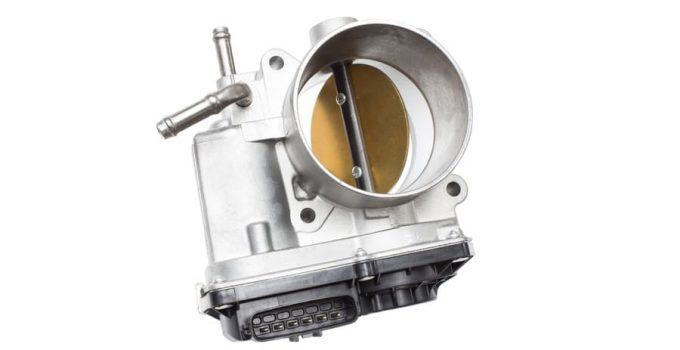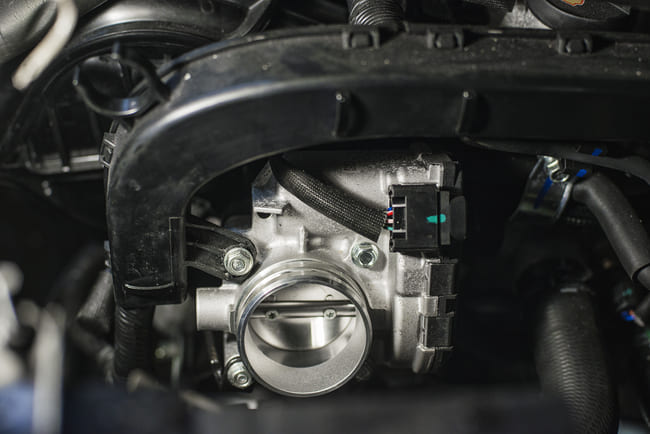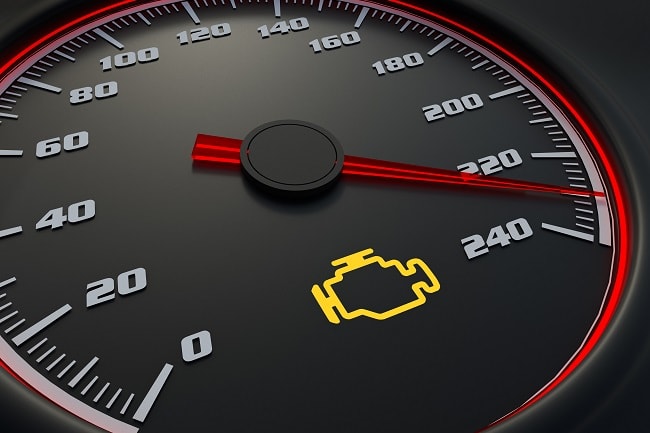
The throttle valve is an important component of a petrol engine and contributes significantly to the safety of the vehicle. It is located in the intake tract, where it regulates the flow of air from the intake manifold to allow precise metering of the fuel-air mixture for the internal combustion engine. Since the throttle body is designed for the life of the vehicle and mainly comes into contact with filtered air, mechanical failures, while rare, cannot be entirely ruled out as it can become fouled and damaged by deposits and dirt particles. A contamination or a defect can be recognized by various symptoms, which are described in more detail in this article. In this case it is necessary to clean or repair or replace the throttle body.
Contents
What is the function of a throttle body and where is it located?

The throttle valve is a movable, circular sheet of metal that is required to regulate the air intake of internal combustion engines, allowing the engine to operate optimally and reducing the amount of pollutants emitted. On newer fuel injected cars, the throttle body is located in the throttle body between the air cleaner and intake manifold, along with all the components necessary for its smooth operation. In older vehicles with a carburettor engine, on the other hand, the throttle valve is installed directly in the carburettor.
It is necessary because the fuel-air mixture required to operate a combustion engine is only ignitable in a certain ratio. The air that is needed to burn the fuel is sucked in from the environment via an intake manifold and delivered to the engine through the throttle valve in the required ratio. The opening of the car's throttle valve is controlled by the gas pedal. In older vehicles, this is done mechanically via a linkage or a cable, in modern vehicles electronically via the engine control unit, which calculates the optimal ratio between air and fuel depending on the power required. The further the driver presses the accelerator pedal, the further the throttle opens and the more air gets into the engine. For example, when the pedal is pushed all the way down, the throttle is opened all the way, releasing the full opening of the intake manifold. The intake pipe, on the other hand, is closed when the accelerator pedal is not pressed.
Normally each engine has only one throttle body. In sports cars, on the other hand, each cylinder often has its own throttle valve, which is located directly in the intake manifold. By using several throttle valves, a significantly larger amount of air can be sucked in, which enables the high performance of the sports car engines. Diesel engines, on the other hand, don't actually need a throttle valve at all. However, newer models often have a shut-off flap or intake manifold flap that regulates and throttles the amount of air drawn in in order to precisely control the exhaust gas recirculation and prevent the engine from jerking and stuttering when switched off.
Causes of a dirty or defective throttle

Since the throttle valve in the engine's intake tract is installed in a relatively protected manner and is designed for the life of the engine, sudden damage and defects, for example due to mechanical stress, occur extremely rarely. Most defects are therefore more likely to develop over a longer period of time due to internal contamination in the intake manifold, deposits of combustion residues and wear of the throttle valve shaft or shaft bearings. Due to the deposits and dirt, the throttle valve can no longer close the intake pipe properly, which not only damages the throttle valve in the long run, but can also damage the engine, the clutch and the transmission. Such contamination and deposits occur primarily in cars that are often only driven short distances.
Symptoms of a dirty or defective throttle valve
As a driver, you often notice a dirty or defective throttle valve because the engine stutters and no longer runs smoothly.
Other symptoms are:
- ! RPM fluctuations at idle
- ! Failure of cruise control
- ! reduced engine power increased fuel consumption
- ! Irregular driving style
- ! Stuttering when accelerating
- ! Illuminated “Check engine” indicator light (engine failure lamp)

- ! slow or delayed decrease in engine speed when the driver takes his foot off the accelerator
- ! Startup problems
- ! bad throttle response
Cleaning or repair of a dirty or defective throttlevalve
In order to decide whether the car's throttle body needs repairing or just cleaning, it is necessary to visually inspect the throttle body. To do this, the throttle valve must first be removed. Depending on the model, it is necessary to remove the engine cover, the air filter box or the intake hose. In addition, the connector must then be loosened. Only then can the throttle valve be removed, usually together with the throttle valve housing and servomotor in modern vehicles. The visual inspection now checks whether the throttle valve is just dirty or there is a defect. If the flap is only dirty or deposits are visible, it is usually sufficient to clean the flap with a special brush and cleaning agent.
The special cleaning agent is available from specialist car dealers and supermarkets. It is essential to ensure that it is acetone-free, as acetone removes grease from surfaces and can damage the engine. When cleaning the throttle valve, be extremely careful not to damage the valve.
- Disconnect the battery, disconnect the negative terminal (on the right side of the battery).
- Unscrew the engine cover, if equipped, with a flathead screwdriver to expose the throttle body.
- Carefully unhook the throttle cable and remove all hose connections to the anti-carbon filter and the air filter. To do this, press the hose clamps together with a pipe wrench; you need a flat screwdriver for the engine ventilation hose.
- Remove the vacuum hose in order to then be able to remove the throttle valve.
- Remove the connector with Allen screws and remove the throttle valve from the intake manifold separate.
- Remove coarse dirt from the housing.

- Spray the throttle valve with cleaning spray and leave it to take effect.
- After a few minutes, rub the valve dry with a clean cloth.
However, if cleaning is not sufficient because the throttle valve is defective, it must be replaced, as repairs are not financially worthwhile. In principle, you can clean and replace dirty or defective throttle valves yourself, but it is advisable to visit a professional workshop, especially for newer cars and cars with several throttle valves, since today's engines are often equipped with sophisticated technology that must be readjusted after cleaning or replacement and the new throttle valve must be taught in. After the new flap has been taught in fully automatically with the ignition switched on, a journey of several kilometers is necessary to finally complete the setting. It is therefore essential that you have the relevant specialist knowledge if you want to carry out the cleaning or replacement yourself, so that the engine then runs smoothly again and all throttle valves are opened and closed synchronously again.
Conclusion
Is your car's engine sputtering and jerking? Reduced engine performance can indicate that the throttle valve is no longer working properly due to dirt or a defect, causing the air-fuel ratio in the engine to be incorrect. If this is the case, the throttle body must be cleaned or replaced as soon as possible to prevent costly consequential damage to the engine, clutch or transmission. If you have the necessary expertise, you can do the cleaning or replacement yourself, otherwise it is advisable to go to a professional workshop.

Comments – 1
@user_1120348 08/24/2022 Member
Great! Thanks very much! Very informative!
A little tip: I think you mean the activated charcoal filter instead of the anti-charcoal filter…. 😉